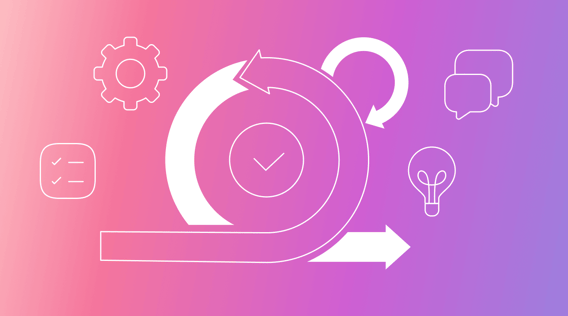If you have participated in any project, you have probably heard the words collaboration, communication, feedback, and incremental value. People often use these terms as essential ingredients for project success.
You may have experienced project failures because of uncoordinated efforts. What do you do when clients request significant changes a few weeks before delivery? Even worse, what do you do when you realize a bit late that the project deliverables are unattainable?
These are common questions that keep project managers awake at night. Small business owners face the same fate, especially when taking on the project manager role.
Instead, project managers can adopt the Scrum framework for improved project success. Many people often use the terms framework and methodology interchangeably when discussing Scrum. However, this is wrong. Scrum is not a methodology. It is a framework used to implement Agile methodologies. According to a recent survey, at least 87% of respondents confirmed they leveraged Scrum to improve project delivery times and overall project success.
This article discusses the Scrum framework, including its definition and benefits. We also explore how to implement Scrum in Agile methodologies, scrum ceremonies, and principles of the Scrum framework.
What is the Scrum framework?
The Scrum framework is founded on the basic principle of continuous incremental value. It involves implementing a project in short cycles. This allows Agile teams to review past performance and incorporate the feedback and recommendation into the next short cycle. The goal of the Scrum framework is to provide the most value for the end user. This requires continuous progress reviews and a reliable feedback loop.
The name Scrum is borrowed from a common rugby term, scrummage. Jeff Sutherland and Ken Schwaber, the creators of Scrum, liken the framework to what happens in the sport. During a rugby game, the whole team comes together and forms a scrummage to help carry the ball forward. Similarly, the Scrum framework requires the collaboration of all relevant stakeholders to carry a product forward or establish the most adaptive solution for the focus problem.
Scrum roles
The Scrum framework emphasizes collaboration, clear communication, and transparency among stakeholders. But who are these stakeholders? Scrum comprises three primary roles: product owner, Scrum master, and development team.
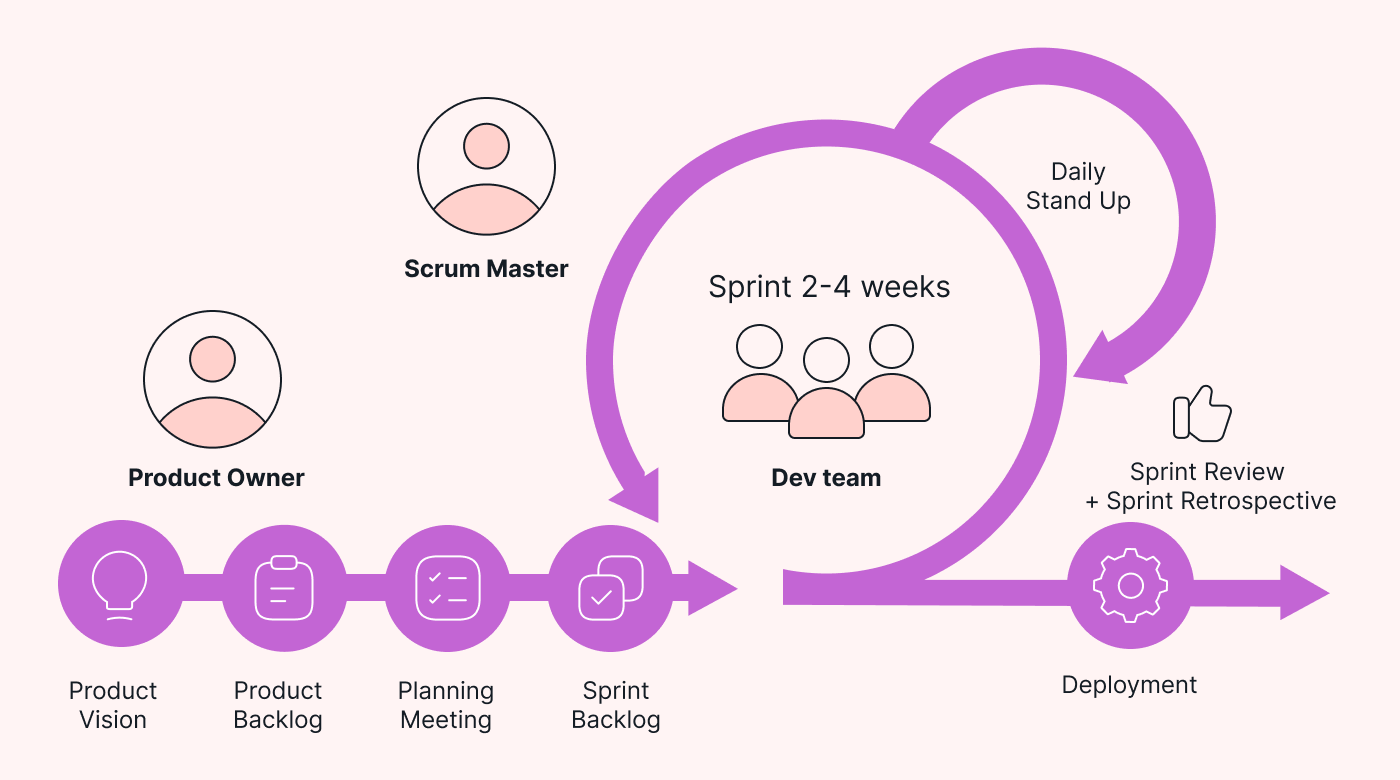 |
Product owner
The product owner is the vision bearer of the Scrum team. They are responsible for ensuring the final product meets end-user expectations. The product owner is also responsible for managing the product backlog items. This involves several functions, including:
- Defining the product goal,
- Identifying, prioritizing, and communicating items on the product backlog, and
- Ensuring the Scrum master and development team understand the product backlog
Scrum master
The Scrum master implements the Scrum framework and principles within the product development process. One major Scrum master role entails explaining Scrum theory and practice to the development team.
They must also coach the development team on effective Scrum practices for efficiency. One such strategy is prioritizing high-value increments. They should also identify and address arising challenges and risks that may undermine the sprints.
Development team
The development team entails all people in the Scrum team who are involved in completing tasks within sprint backlogs. Most development teams comprise multidisciplinary members, ensuring the team can fulfill all tasks related to a sprint backlog. An example would be a software development team comprising the following:
- User interface designer,
- Software developer,
- Systems architect, and
- Software quality analyst.
During daily Scrums, the development team assesses its progress toward the sprint goal and identifies effective ways to ensure the goals are achieved and on time.
Benefits of the Scrum framework
Small business owners stand to gain a lot from integrating Scrum into their Agile methodologies. The benefits span time, resources, and process efficiencies. Let’s review the benefits in detail.
Better prioritization of tasks
Small businesses can use the Scrum framework to prioritize tasks based on their urgency and value. A common strategy is using a value-based prioritization list that assigns a score or rank to each user story. The Scrum team may also account for uncertainties and dependencies, allowing them to deliver the most value early, then build on it.
Better KPI monitoring
Scrum provides a standard way of monitoring and assessing performance. KPIs should be clear and concise for accurate monitoring. For example, the Scrum team may monitor how many user stories have been completed, how many are pending, and how many have encountered risks or uncertainties.
Timely incorporation of suggested changes
The Scrum framework is iterative, allowing the Scrum team to modify the product continuously based on the received feedback. The product owner modifies the product backlog based on changes in user stories. This provides a basis for changing the sprint backlogs for the next cycle.
More control over project risks
The iterative approach used by Scrum increases risk predictability and control. The Scrum team delivers changes to clients in short cycles and receives feedback. This means any changes in user stories are addressed timely, ensuring the progress does not veer too far from the desired outcomes.
Efficient use of time and money
A lot of projects fail because of time and money constraints. Scrum solves this in several ways. First, the development team holds daily Scrums to assess progress and adapt the sprint backlog where necessary.
This saves time otherwise lost when using traditional sequential processes comprising longer decision-making cycles. Regarding cost efficiency, Scrum reduces the frequency of mistakes, mitigating resource wastage.
How Scrum implements the Agile methodology
Scrum entails one of the most used frameworks within the Agile methodology. However, to understand how Scrum is used in Agile, we must first understand what it involves.
What Agile methodology entails:
The Agile methodology is characterized by the continuous, iterative development of a product. A good Agile methodology emphasizes doing development and testing activities concurrently. This allows the test results to inform future activities, ensuring the final product meets expectations.
Using Scrum in an Agile environment:
Now that we know what Agile methodology is, it becomes easy to understand how to use Scrum in an Agile environment. The Agile methodology requires the development and testing functions to be done side by side until the project is complete. Scrum does this through its sprint ceremonies. Items in the product backlog are split into sprints.
Next, the Agile team plans, executes, and reviews the splint goals. Following a review, the product owner may adapt the product backlog based on changes in user stories. This, in turn, influences the next sprints, as they are modified to incorporate the suggested improvements.
How Kanban is different from the Scrum framework:
Many people often compare Kanban and Scrum, given they are the two most popular frameworks within the Agile methodology. The two frameworks differ significantly in setup, team roles, and principles.
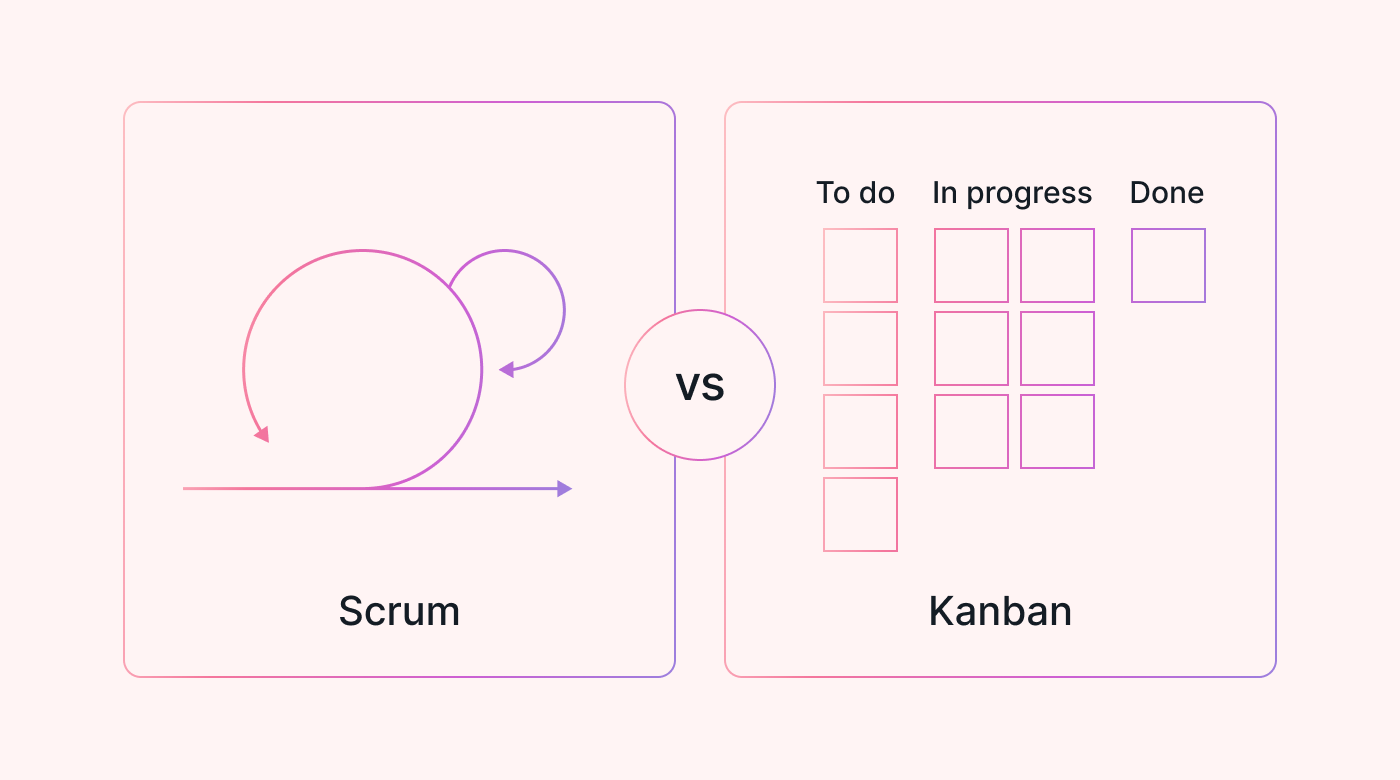 |
Kanban exploits project visualization to identify and clear bottlenecks that would otherwise slow down a project. The goal is to release updates whenever ready, marking previous work in progress as done. Work is “pulled” into the workflow by team members.
In contrast, Scrum splits items or user stories in the product backlog into smaller units called sprints. The development team then undertakes activities within the sprints that often last up to a month. Work is “pushed” through the sprints.
Principles of the Scrum framework
Scrum operates on three primary principles that align with the Scrum theory. Fundamentally, the Scrum framework uses cross-functional teams to ensure an iterative, incremental approach. This is only easy if all relevant stakeholders adhere to stringent Scrum philosophies and principles.
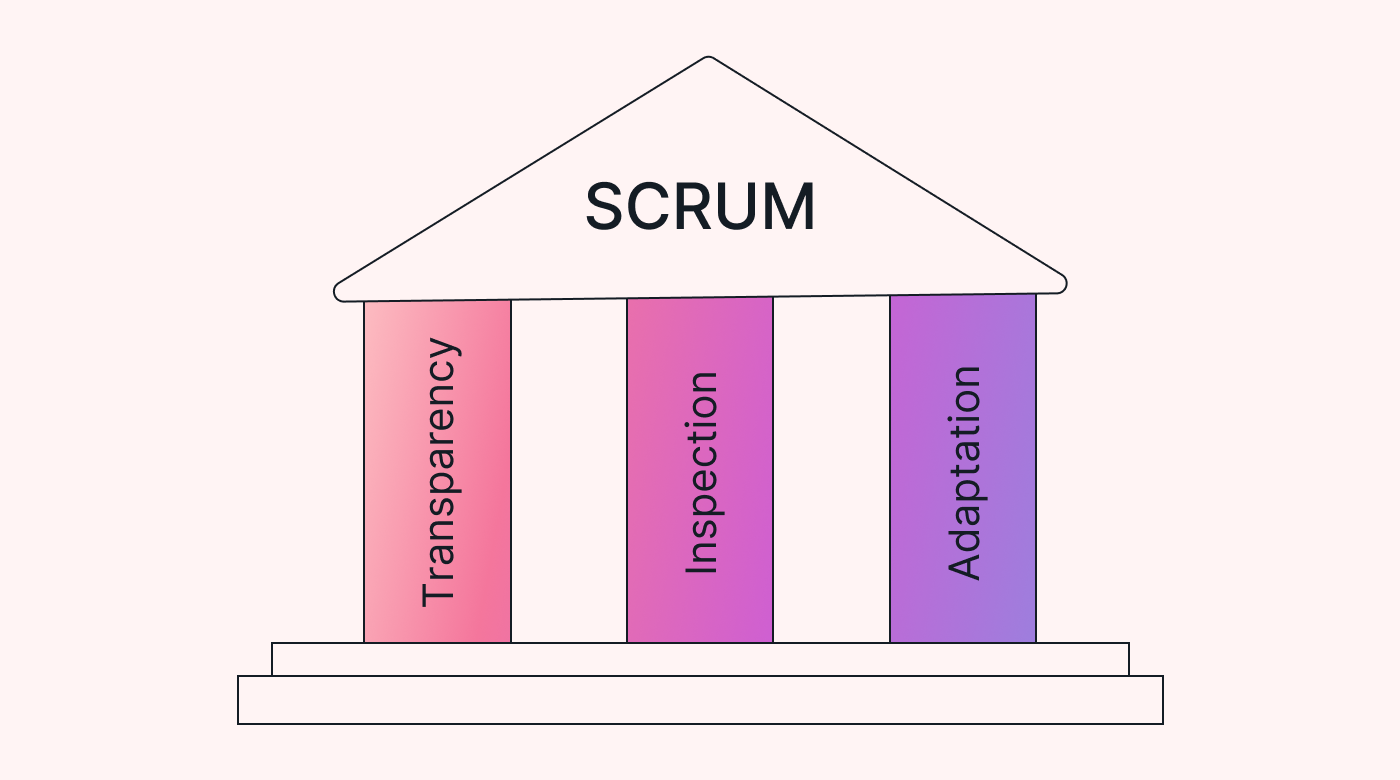 |
Transparency
The Scrum framework heavily relies on using information from what is observed to guide decisions and strategies. The stakeholders rely on the perceived state of the product and sprint backlogs to modify the items. This means that low transparency may misguide Scrum team members into making wrong decisions, altering the expected outcomes.
Inspection
The Scrum team should inspect the Scrum artifacts on a regular basis to ensure they do not deviate from the desired outcomes. Inspection relies a lot on transparency and the accuracy of the availed feedback. On the other hand, inspection guides the recommended steps for adaptation. Moreover, the inspection should be thorough to ensure possible challenges and risks are not overlooked.
Adaptation
Adaptation provides the best solution for steering the progress toward the expected outcomes. The Scrum team should modify processes or approaches in the shortest time possible to mitigate further deviation. The development team should also be empowered to initiate adaptation as soon as they ascertain deviation.
5 Scrum ceremonies
Scrum ceremonies, also known as Scrum events, provide opportunities for inspecting and adapting Scrum artifacts (product backlog, sprint backlog, and increment). They also boost transparency, a major principle of the Scrum framework. Let’s discuss the ceremonies in detail below.
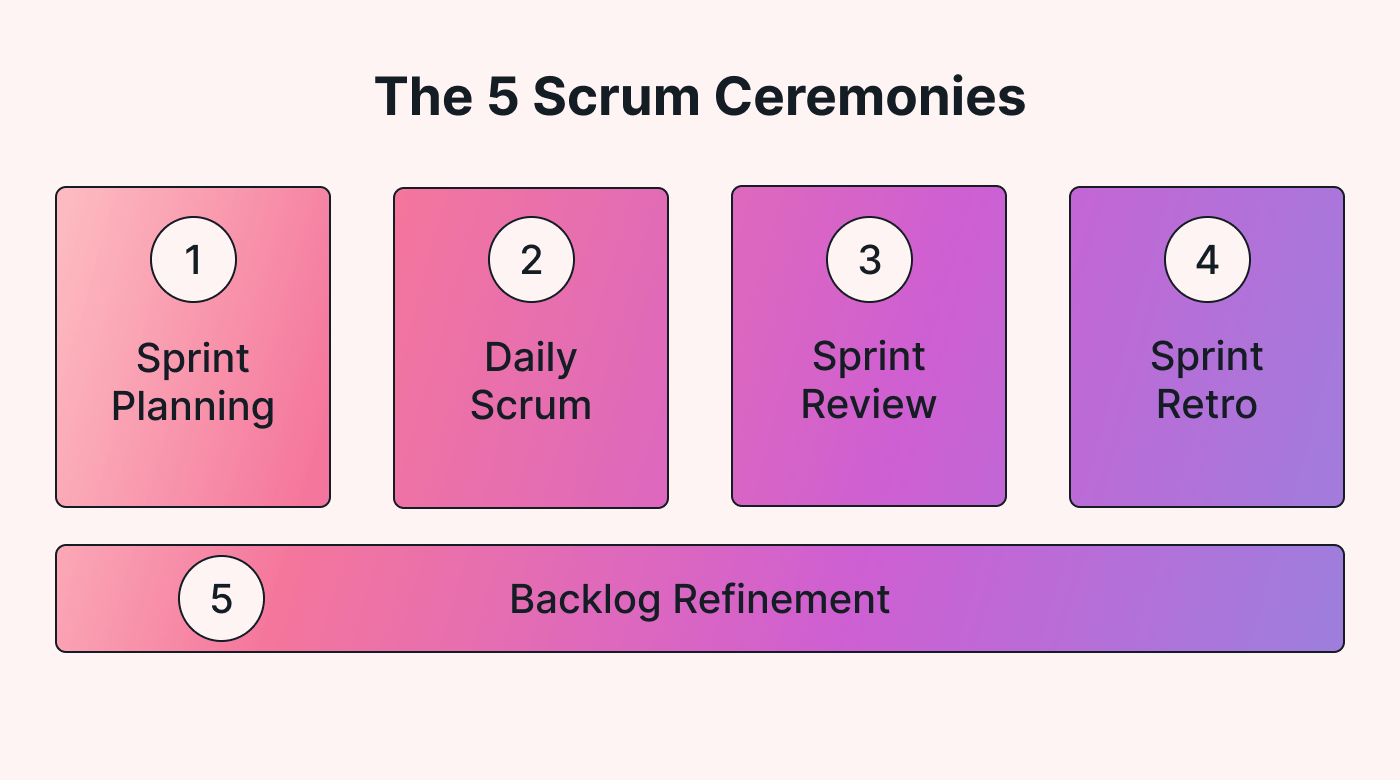 |
Sprint planning
During sprint planning sessions, the Scrum team defines the work to be done within a specific sprint. The Scrum team also includes a priority list for the sprint, ensuring the most important activities are undertaken first. Each Scrum team member has a unique role during sprint planning.
The product owner describes the desired outcomes based on the user stories included in the product backlog. The Scrum master facilitates the meeting, ensuring adherence to Scrum philosophies and values. Lastly, the development team confirms how much work they can complete within a sprint cycle.
Daily Scrum
Scrum teams should use daily Scrums to inspect and adapt their sprint backlogs. Most daily Scrums last about 15 minutes, just enough to review the day’s progress and make any adjustments for the following day’s work. The product owner and Scrum master may be present depending on their involvement in completing specific sprint activities.
An effective strategy for this Scrum ceremony is to schedule daily Scrums at the same time and venue during the working days. Additionally, the Scrum team should ensure the daily Scrums are thorough. This avoids holding other meetings during the day or sprint, which wastes time and money.
Sprint review
The Scrum team should hold a sprint review at the end of a sprint. It is an opportunity for the development team to present what was achieved during the sprint. Relevant stakeholders, including customers, users, and senior managers, may be present during the review.
End users and customers can test the delivered features and provide feedback. For example, suppose the delivered outcome at the end of a sprint is an e-commerce website’s homepage. The Scrum team may allow end users (customers) to interact with the page. The customers may then provide user stories based on their experience.
The presented results during the sprint review provide opportunities for the product owner to adapt the product backlog. Any changes to the product backlog will likely require the Scrum team to adapt the next sprint to ensure it aligns with the desired outcomes.
Sprint retrospective
The sprint retrospective focuses on process efficiency. It seeks to identify what went right or wrong. The identified problems provide opportunities for improving the process in readiness for the next sprint. In some situations, the identified challenges might have been addressed during the daily Scrums.
The Scrum team should identify any impactful changes and inspect whether they should be adapted to the sprints. Scrum masters play an essential role during sprint retrospectives by encouraging a culture of continuous improvement to achieve sprint goals.
Backlog refinement
Backlog refinement should be a continuous process undertaken throughout the sprint. The Scrum team should refine the sprint backlog based on changes in priority and the value of the sprint items. Similarly, the product owner may change the product backlog after a sprint review and retrospective.
For example, an outcome that may have previously been considered the second most valuable product goal may drop to fourth after changes in user stories. Backlog refinement is not a one-time thing. Instead, the Scrum team should refine the sprint and product backlogs throughout the sprint and Scrum process.
Improve your project management process by adopting the Scrum framework
Clear communication channels, collaboration, and continuous improvement are essential for project success. The Scrum framework provides a guide for incorporating feedback into the process, ensuring the final deliverables meet expectations.
Project managers and small business owners can use Motion to implement the Scrum framework for their projects. Motion allows you to schedule meetings during the initiation phase and planning. For example, you can use Motion to schedule the sprint reviews and sprint retrospectives.
Whereas the daily Scrums are often held at the same time and venue, you can use Motion to disseminate the inspection results and agreed-upon adaptations. The Scrum master can also use Motion to delegate responsibilities to team members.
Small businesses and Scrum masters overseeing projects should start with Motion’s free trial today!

